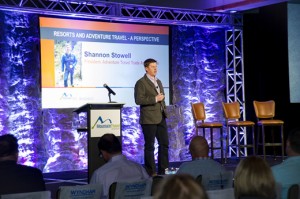 The Mountain Travel Symposium in Breckenridge, Colorado, is the longest running annual gathering of mountain travel professionals in North America. Representatives from mountain resort businesses have gathered at MTS each spring for nearly 40 years.
The Mountain Travel Symposium in Breckenridge, Colorado, is the longest running annual gathering of mountain travel professionals in North America. Representatives from mountain resort businesses have gathered at MTS each spring for nearly 40 years.
The symposium invited ATTA President Mr. Shannon Stowell this year to provide some insights and thoughts about the adventure travel industry and to discuss possible opportunities for resorts to increase their business opportunities -- especially in the summer when visitor numbers are often higher but the capture of business by the resorts is often more difficult.
The snowsports industry is facing two major challenges. Firstly, the industry is in a decline and has been for a number of years. A number of factors including aging of the demographic, cost, perception of difficulty, etc., keep new potential skiers and boarders from learning. Secondly, more unpredictable weather is occurring related to climate change. Resorts need snow -- lots of it and reliably -- to have good, profitable seasons. Similar to retailers who do most of their business during the three months leading up to Christmas, ski areas also follow the 80/20 rule: 80% of the business in 20% of the year.
Stowell spoke on top level trends in the adventure travel industry, which show rapid growth of the market. After spending time with numerous experts (professors, ski resort owners and marketers, technology companies, etc) in advance of the event to better understand the industry, Stowell focused his talk on two themes: “Ecosystem Development” and “Capturing the Adventure Traveler.” The following are excerpts from Stowell’s keynote address.
“Ecosystem Development”
There are numerous small adventure operators -- rafting, hiking, biking, fishing, zipline, etc. -- in resort areas. And they are on their own, with typically very small marketing budgets. If the resorts would view themselves as “accelerators” to this ecosystem, they could utilize their own firepower (marketing, exposure, etc) to get the stories of all these companies out to their prospective guests. Historically the resorts only want to promote the resorts but I think this is where an opportunity does lie. Multi-generational travel is growing. Adventure travel is exploding. And when a family of 10 comes to a resort town in winter, not everyone will ski. And when they come in summer, interests of the group will be varied.
Imagine the resort telling the story for all the operators with whom they work to increase the overall attractiveness of their region, thus becoming a differentiator for the long term. I think Whistler has done this well. Look at how Whistler is now known not only for skiing but for world class mountain biking. And could it also be known for ziplining, fly fishing, rafting, hiking, backcountry skiing, mountaineering, wildlife tours and more? They can, if they decide to, partner deeply with the ecosystem of small operators within their region. I think resorts who sit the local tour community down together, build trust and understand what will make those ancillary local businesses succeed. They will be building smart partnerships for the long haul and helping diversify business against the two big threats against the industry.
“Capturing the Adventure Traveler”
Today’s adventure traveler is looking for activity, nature and culture. The resorts have nailed the activity sector and they do have somewhat of a connection to nature but more from a groomed/managed/contained angle. The culture part of the equation does not seem to be much of a focal point. What is culture and why does it matter? It could be the aboriginal people’s history, industry history that transformed the area (mining, logging, hunting, trapping, etc), the current culture (mountain? Western?). I spoke with an English family skiing in Breckenridge and asked simply “Why Breckenridge?” and they responded that usually they ski in France but wanted a “uniquely American” experience. And they got it in the town of Breckenridge. Resorts will clearly always get the local business but they may be missing the big international opportunities offered by adventure tourism.
Resorts, I believe, will have to undergo a shift in thinking. There is a mindset of ‘capturing everything within our borders,’ which means that the revenues for lodging, lift tickets, food and beverage, etc are all captured by the resort. The new thinking may mean working with tour operators bringing foreign guests to the area and accepting that on an eight-night itinerary, possibly only one or two of those nights might be at their resort. It may be part of a package. So for example, Jackson Hole Mountain Resort could potentially have some add-on opportunities for the international visitor to Yellowstone.
After Stowell’s talk, Adam Sutner, CMO for Jackson Hole Mountain Resort, and Erik Austin, VP Marketing & Sales for Whistler-Blackcomb, joined him on stage for a “fireside chat”.
“Meeting and hearing Shannon Stowell’s passion for the Adventure Travel industry was an eye opener for me,” said Adam Sutner. “The possibilities for a resort like Jackson Hole are more obvious now. We’re looking forward to developing its potential”.
Whistler-Blackcomb’s Erik Austin added, "This session was an important start to discuss the opportunities of how to better integrate with the adventure travel industry."
It is certainly the ATTA’s hope that this discussion continues in the winter resort community.
